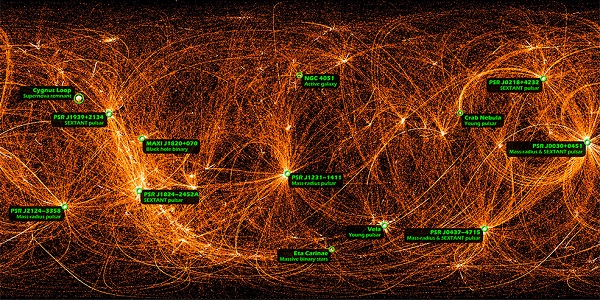NASA's NICER instrument aboard the International Space Station is giving us a unique view of much of the X-ray sky.
How will deep space missions of the future find their way through the cosmos? The answer may come from the unique experiment that traced this bizarre-looking all-sky view.
The image is courtesy of NASA's Neutron star Interior Composition Explorer (NICER), an instrument mounted on the Integrated Truss Structure on the exterior of the International Space Station. Over 22 months of observations, NICER has slewed from one target to the next, tracing out a view of much of the sky. NICER observes up to 4 targets per orbit as it speeds around the Earth once every 93 minutes. NICER must pirouette during each nighttime pass to complete its observations, a dance that can be seen in the time-lapse below:

NASA / GSFC
NICER has traced a rough sweep along the plane of the Milky Way galaxy, home of several nearby pulsars. Notable sources in the image include the Vela pulsar 163 light-years away, and the Crab Nebula pulsar in the constellation of Taurus the Bull, the remnant of the supernova in 1054 AD recorded by Chinese astronomers.
“Even with minimal processing, this image reveals the Cygnus Loop, a supernova remnant about 90 light-years across and thought to be 5,000 to 8,000 years old,” says Kieth Gendreau (NASA-GSFC) in a recent press release. “We're gradually building up a new X-ray image of the whole sky, and it's possible NICER's nighttime sweeps will uncover previously unknown sources.”

NASA / NICER
NICER traveled to the ISS aboard on SpaceX Dragon spacecraft in 2017. The instrument observes so-called "soft" X-rays, with energies from 200 to 12,000 electron volts. Special optics concentrate (as opposed to focus) these X-rays onto silicon-based detectors.
NICER's primary mission is to make accurate measurements of pulsars across the sky. Pulsars are remnants of stars that ended their lives in violent supernovae explosions. The dense, city-size cores spin rapidly and cast out jets that fly along their magnetic poles, sweeping rapidly across Earth. Near the poles, the surface of the pulsar heats to X-ray-emitting temperatures, and by measuring how the X-ray brightness changes as the pulsar rotates, astronomers can gauge the pulsars' mass and radii to a precision of 5%. Astronomers will use this data to characterize the composition and state of pulsars' incredibly compressed interiors.
A Galactic Positioning System
NICER plays an integral part in another ISS-based project: the Station Explorer for X-ray Timing and Navigation Technology (SEXTANT). In this experiment, NICER utilizes pulsars' extremely reliable X-ray flashes to measure its exact position.
Global Positioning Systems (GPS) use satellites in Medium Earth Orbit (MEO) to calculate exact positions on and around Earth, but deep space missions require a different source for autonomous positioning. SEXTANT serves as a test-bed for a next-generation GPS, as in "galactic positioning system": ultimately, such a system will enable missions throughout the solar system to get a fix on their position via pulsar timing measurements.
In addition to NICER/SEXTANT, the ISS hosts another astrophysics observatory: the Alpha Magnetic Spectrometer (AMS-02), which measures cosmic ray hits from electrons and their antimatter partners, positrons. The ISS provides an ideal platform from its low-Earth orbit vantage point for such experiments; the AMS, for example, require copious amounts of power, so it wouldn't have been able to fly as an independent experiment. Also, science packages on the ISS can be upgraded and repaired as needed.
The FY2019 NASA budget proposal seeks to end ISS funding in 2025, with a possible switch to private funding. To that end, NASA will announce on June 7th a "five-point plan to enable commercial and marketing activities aboard the International Space Station, with a long-term goal to achieve a robust economy in low-Earth orbit." We'll see what that plan holds in store for future science missions such as NICER, SEXTANT, and the AMS-02 experiment.
 5
5










Comments
Anthony Barreiro
June 4, 2019 at 3:06 pm
From the positions of the Cygnus Loop, Eta Carinae, the Vela SNR, and the Crab nebula, the all-sky image seems to have an equatorial orientation. Is this correct?
I would hate to see the ISS become a privatized commercial enterprise. NASA is only one partner in the ISS. Are Canada, Japan, Russia, and the EU (with or without Great Britain) also planning to privatize their shares in the station?
You must be logged in to post a comment.
David DickinsonPost Author
June 4, 2019 at 7:17 pm
Hi Anthony,
Correct... the celestial equator horizontally bisects the map.
You must be logged in to post a comment.
Anthony Barreiro
June 5, 2019 at 3:16 pm
Thanks David. This got me thinking about what would be the best way to orient a map for celestial navigation within the solar system. The ecliptic would be a good first approximation, and the invariable plane of the solar system seems the most fundamental baseline. Earth's equator doesn't have much to do with the rest of the solar system. If we ever journey beyond our solar system, the galactic equator would be the best baseline. We'll need to get new maps.
You must be logged in to post a comment.
Stephen Gagnon
June 4, 2019 at 9:45 pm
The GPS satellites aren't in geosynchronous/geostationary orbits.
You must be logged in to post a comment.
Bob
June 8, 2019 at 11:08 am
Thanks for the article.
You must be logged in to post a comment.
You must be logged in to post a comment.